#either an archaeopteryx
Text
Prompt:
The Bat Family as shifters.
But they’re all some extinct animal.
#prompts#look we could go back as far as dinosaurs#or we stop at mammal extinction#Jason could be either a dire wolf#or a sabretooth#or even a spinosaurus#Tim would be either a velociraptor#or a Tasmanian tiger#Bruce would be a good ol TRex#or a short faced bear#Dickie would be some kind of bird no contest#either an archaeopteryx#or an Argentavis Magnificens#lmao how funny would it be if Damian was a herbivore tho#surrounded by carnivore shifters#so maybe triceratops#or maybe a Quagga#ok anyway that’s it#batfam#batfamily#jason todd#bruce wayne#dick grayson#robin#tim drake#Damian wayne#red hood#shifters#alternate universe#the awkward moment when your instincts tell you to hunt your baby brother
80 notes
·
View notes
Text
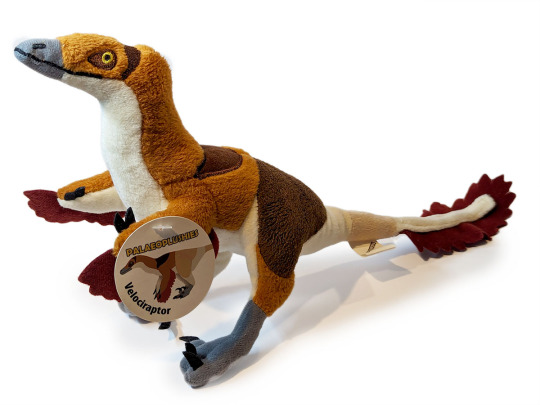

I found some left over stock from the Kickstarters I ran in 2014 and 2017! Velociraptor and Archaeopteryx!
My opinions on creating mass-produced plush toys has changed since I designed these, so I doubt I will ever run another kickstarter, so this is your last chance to grab either of these designs!
You can find them over here:
www.palaeoplushies.com
280 notes
·
View notes
Note
i was rewatching the rite of spring segment from fantasia and i've got to wonder. Why Did We Draw Archaeopteryx Like That. i remember toys having that same, boomerang arm shaped pose too. it's like a monkey lizard more than a bird.
Ooh okay this is a fun one cause while it technically is an Archaeopteryx and is listed as such in the production draft, I don't think the design is based on Archaeopteryx at all!
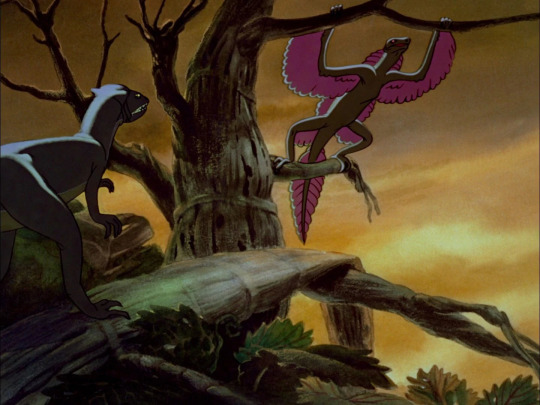
To me, this "Archaeopteryx" almost exactly resembles something else, the fascinating historical phenomenon called Proavis.
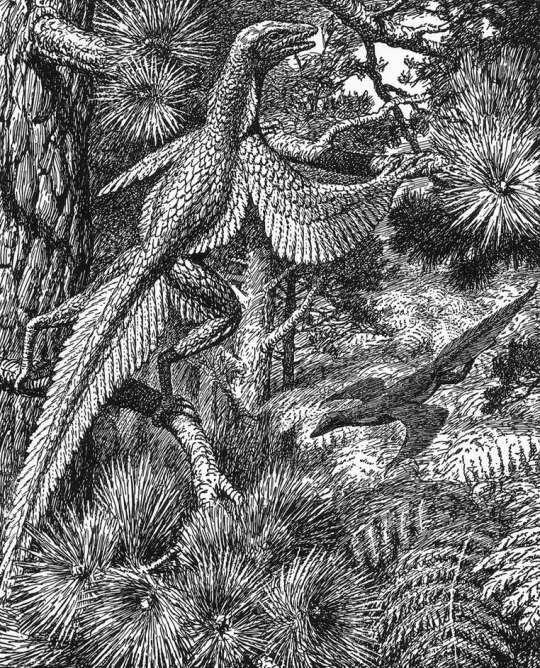
Proavis, or Tetrapteryx as some four-winged interpretations were called, was a hypothetical prehistoric creature that was proposed in the early 20th century as a best guess at what the unknown ancestor of birds could have looked like. The illustration above was drawn in 1926 by Gerhard Heilmann, a Danish artist and amateur scientist who argued that birds evolved from non-dinosaurian archosaurs like Euparkeria. In his 1916 book Vor Nuvaerende Viden om Fuglenes Afstamning and the 1926 English translation The Origin of Birds, he presented Proavis as the imagined midpoint between a scaly ground-running archosaur and Archaeopteryx, which at the time held the title of The First Bird.

Other versions of the same hypothesis, like William Beebe's Tetrapteryx above, were published and discussed around the same time, but it was Heilmann's Proavis that gained immense popularity to the point that bird evolution was considered essentially "solved" for decades. It was also painted by Zdeněk Burian, one of the Old Greats of palaeoart, which kept the concept alive in dinosaur books for decades as well.

Of course further study has shown this hypothesis to be incorrect and that birds are instead members of Dinosauria (and honestly Heilmann either missed or ignored a lot of evidence for a dinosaurian origin of birds even in the 1910s), but the Proavis to me remains a beautiful and fascinating concept that represents scientists and artists striving to understand the prehistoric world and the passage of evolution, much like we still do today!
And of course, its popularity in the early 20th century put it at the perfect time for Fantasia's artists to take... let's say heavy inspiration from Heilmann's imaginary Proavis when depicting a creature that was intended to be Archaeopteryx the whole time! The pattern of feathers matches up almost exactly, although the larger leg wings might have been inspired by Beebe's Tetrapteryx as well:
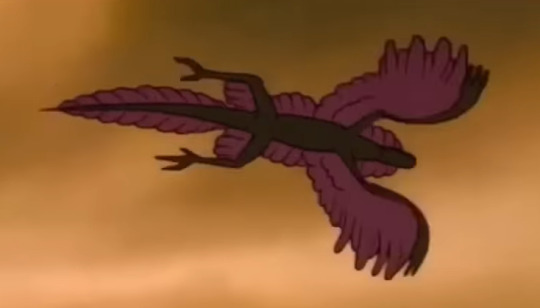
So to get back to your original question that led to this whole deep dive, artists didn't actually Draw Archaeopteryx Like That except when they were mistakenly drawing something that wasn't Archaeopteryx at all! If you want to read more about the Proavis and Tetrapteryx I recommend this Tetrapod Zoology blog post by Darren Naish, he does into more depth about the history of the concept and some of the unusual evolutionary ideas that Heilmann used to arrive at this weird and cool imaginary creature!
791 notes
·
View notes
Note
Wait is that actually your ex-boyfriend's hand? What happened to him?
He works with real live dinosaurs so....
Nah, he and are are super good friends--we were before we dated, and remained so after, because the breakup was extremely amicable, and he's one of those people who's a terribly good gift-giver. Most years we still exchange gifts sometime between our respective birthdays and christmas, and he sent me that hand (it's a replica) as a gift one year. I made him the archaeopteryx fossil bowl this year.
Just because this is the OG bone-stealing witch website, I will clearly state that the only real human bones I possess are my own. My animal bones are all either scavenged myself or gifted to me by the people that scavenged them. (I have a sort of energy that consistently makes people go "I saw this dead thing and thought of you!")
I don't have a problem with owning human remains that are ethically sourced, but the reality is that unless you can very precisely trace the origin of human remains to the specific person who clearly and unequivocally stated in life that they're cool with someone keeping and displaying their now-unused crunchy bits, it's...probably not ethical. So if someone has some of their own bones that they're done using that they want to send my way: cool, let's talk, ideally before it's necessary to have the conversation by seance. Otherwise, I will continue to be perfectly happy with my replica remains.
I'd like to will my crunchy bits to someone who will make dramatic monologues to my noggin, but hopefully that's not an issue I'll need to deal with for a while yet.
#is the gift giving secretly a competition? maybe but in a fun way! both of my college ex boyfriends and I are still close#in fact we're all going on a big college buddies camping trip this summer#my third college ex boyfriend no longer exists#because she came out as trans#good for her!#we are also still on friendly terms but we don't keep in touch as much#anyways truly genuinely i dont care what's done with my body after i die but I DO want my estate used#to put up a really dramatic ominous angel in a cemetery somewhere#so that future melodramatic counterculture kids have a place to take terrible futuremyspace selfies#it is the gift i wish to give to future generations#nobodys making morbid statuary for the graveyards anymore
296 notes
·
View notes
Note
All the "birds are dinosaurs" deniers got me thinking:
Is there a specific word to refer to dinosaurs as common non scientific perception defines them??? Like, everything I can think of is either too specific (ie 'jurassic period dinosaurs') or just. "Extinct/prehistorical dinosaurs" or something like that, and that's just... eh. "Extinct" is at least kinda funny because it includes ivory billed woodpeckers but not pileated woodpeckers lol
Sometimes when I speak about dinosaurs to friends and stuff (and what that one person who was like "I want to see a dinosaur and it makes me sad that I can't!" person was probably getting at) I want to specifically refer to the sorts of species that are old enough to be fossils, you know? Including the old avian dinosaurs! :)
Apologies if you've answered this sort of ask before! But since I don't know the word I cannot search your blog for it lol. Thank you in advance, I love seeing you on my dash and learning things!
so there's a few different things you could mean depending on the situation.
here's the thing:
what's a bird, to you?
if you want the smallest group you can pick, ie the clade that consists of all the birds of today and nothing else, then you mean
"non-neornithine dinosaur"
aka
dinosaurs that aren't in Neornithes, which is that smallest possible group
so if you want to say "nonavian dinosaur" (aka, a dinosaur that isn't a "bird") you have to know what you're saying
bc there is also "nonavialan dinosaur", that is often just "nonavian dinosaur", aka the group of dinosaurs that have traditionally been considered as such exclusive of things that sometimes got put with birds instead
aka it includes Velociraptor but not Archaeopteryx
but the difference between the two is honestly miniscule at this point and things jump around a lot. many scientists do not think that's how we should define bird versus "classical dinosaur"
hence non-neornithine, aka neornithes being just the dinosaurs that survived the end-cretaceous extinction (most likely don't worry about it) and into the cenozoic, and non-neornithine dinosaurs being all that went extinct
being the most exact term for what you're looking for
you also could just go simple and do "classical dinosaurs"
but most often you'll see "nonavian dinosaur" which usually means, in practical parlance, non-neornithine dinosaur, or maybe non-avialan. sometimes non-pygostylian if they want to be contrarian, even non-maniraptor(iform?) if they want to be hipster
it's a fun time
what is a bird, indeed
48 notes
·
View notes
Text
Why defining "birds" precisely is hard
(A reply to @lyxthen-reblogs that got too long and is now its own post)
A long time ago (in the 1700s), we didn't really have any idea of how birds came about - evolutionary theory itself would have to wait another century! And, we didn't have knowledge of extinct species either, or even of the fact extinction was a thing. Carl Linnaeus, when setting up the first taxonomical classification of life, grouped modern birds in the class Aves. Mammals were grouped in Mammalia, reptiles, amphibians and cartilaginous fish in Amphibia, bony fish in Pisces, arthropods in Insecta and all other animals in Vermes.
This first classification was pretty crude, and, around 1820, scientists like de Blainville and Latreille began distinguishing reptiles from "batrachians" as separate classes. De Blainville, pointing out similarities between reptiles and birds, labelled the former as "ornithoid" (bird-like) while amphibians were "ichthyoid" (fish-like). In 1825, Latreille fully separated amphibians (Batrachia, later Amphibia) from reptiles (Reptilia).
The first major turning point for taxonomy came in the next decades, as many fossils of now-extinct creatures were unearthed. In 1842, Richard Owen coined the term Dinosauria, then uniting the recently discovered Megalosaurus, Hylaeosaurus and Iguanodon.
But it wouldn't be until the 1860s that Darwinian evolution would highlight the flaws in the earlier understanding of separate classes. In 1863, Thomas Henry Huxley would suggest uniting birds and reptiles, creating the class Sauropsida the next year. Huxley was the first to suggest birds evolved from dinosaurs, comparing the recently-discovered Archaeopteryx (1861) with Compsognathus. As cladistics didn't exist back then, no attempt at precisely extending the definition of "bird" to extinct forms was made, even though Archaeopteryx was usually called "the first bird" (Urvogel).
Unfortunately, this hypothesis would be shelved for a whole century, leading to little progress happening in terms of understanding bird evolution. It wouldn't be until the 1960s and the Dinosaur Renaissance that the links between birds and dinosaurs would be rediscovered, with birdlike theropods like Deinonychus being unearthed. This would really accelerate with the discovery of extremely well-preserved feathered dinosaurs, starting with Sinosauropteryx in 1996.
With numerous fossils showing steps of a gradual dinosaur-to-bird transition, the question of defining the "first bird" came to be asked again. To try to answer this, Jacques Gauthier coined the clade Avialae in 1986 as all dinosaurs more closely related to modern birds than to deinonychosaurs. This included Archaeopteryx, which other authors used for an alternate definition of Avialae: "the smallest clade containing Archaeopteryx and modern birds".
Still, the conflict didn't end there. Fundamentally, there were many ways to extend Aves (as defined from modern birds) to past ancestors, and, in 2001, Gauthier and de Quieroz identified four. Avemetatarsalia, defined as any archosaur closer to birds than to crocodilians (including all dinosaurs and pterosaurs!). Avifilopluma, defined as any archosaur possessing feathers homologous to bird ones. Avialae, redefined as any dinosaur able to fly (and their flightless descendants). And finally, Aves or Neornithes, the crown-group (the last common ancestor of modern birds, and its descendants).
The issues were many. Avifilopluma became mostly useless as a definition as ornithischians, then pterosaurs, were found to possess filaments homologous with bird feathers. Virtually every bird-line archosaur (with the possible exception of the little-known aphanosaurs) could likely fit in this clade, and its content was too uncertain to be reliably used.
Meanwhile, Avialae had (and continues to have) three distinct definitions. Notably, the ability for flight itself proved to be a poor definition, as bird relatives (Maniraptora, including Deinonychus, Velociraptor, Oviraptor, and many other bird-like theropods) likely evolved flight several times, from the four-winged Microraptor to the bat-winged Yi qi. Truly, most maniraptorans were extremely bird-like: wings had evolved much earlier than flight itself, with even dinosaurs like Velociraptor sporting fully feathered wings despite being unable to fly.
So, what was left? The crown group Neornithes, a vaguely defined Avialae, a more extensive Maniraptora, the stem group Avemetatarsalia, and lots of confusion. Usually, Aves is taken today as referring to either Neornithes or Avialae, although Avifilopluma/Avimetatarsalia are also in use (for instance, the Sinosauropteryx discoverers used Avifilopluma, and considered it a bird).
But none of these definitions are inherently better or worse. They are all different ways of extending a definition made for modern creatures to have it apply to past ones.
50 notes
·
View notes
Text
also gamers would any of you mind weighing in... 👉 👈
#these are just some recent miscellaneous things ive been dwelling on LOL nd it might ease some choice paralysis#i probs wont get to them Immediately bcus zink and half dragon zellie are rotting my brain. as usual . but i like to play and draw etc etc#so i would like to doodle all of these Eventually anyways but. You Know.#personal.txt
12 notes
·
View notes
Text

a secondary mlpsona <3 gay ass draconequus. notes under the cut
please reblog my art!
head is a deer, wings are fork-tailed storm petrel, front paws are sea otter, hind legs are osprey, tail is vaguely archaeopteryx, teeth are leopard seal
height wise it is around the same height as luna / cadence? so tall but not Super tall
it is a weather / water draconequus & powers include: some weather / water manipulation & underwater breathing. also it can talk to birds. it often disguises itself as either a reindeer or a peryton in some situations
last but not least heres a silly doodle of it in the mlp style with simplified markings :3

#mlp#my little pony#mlp fim#mlp fanart#mlp oc#mlp sona#mlpsona#draconequus#draconequus oc#sam draws#sona: dovekie#it likes both names equally btw. when in disguise it just uses dovekie
20 notes
·
View notes
Text
WIP Wednesday
Tagging: @bearlytolerant, @silurisanguine, @aro-pancake, @fangbangerghoul, @atonalginger, @aislingdmdt, @fshenkoescape, @ninjaofnaps, @lisa-and-shadow, @a-cosmic-elf, @thatsgoodsquishy0, @hockeydemon42, @fomagranfalloon, @violenceandviolets, and @artemis-crimson
Since I posted an actual chapter for stars today, the WIP is from my other ongoing work, The Odysseus Gambit.
“Where the hell did all these come from?” Jensen swatted away another with a snarl. He’d been getting steadily more irritated over the past hour; she wasn’t all that thrilled about the situation, either.
“Wetlands,” she growled. “Mosquitoes. Pretty simple math.”
“Thanks, Captain Obvious,” he muttered, quietly enough that she decided just to ignore it.
“I’ve got insect repellent in my pack,” she said instead, ruthlessly controlling her annoyance. “Let me find us a place for a break—it’s about lunch time anyway—and I’ll crack it out.” She took a few more steps, and her foot plunged through the ground cover, right into an animal burrow. This one was bad enough to twist her entire leg—perfect joints didn’t have the flex of human tendons—and the connection points at her hip ached where unforgiving metal met all-too-imperfect flesh. Now it was her turn to mutter sotto voce imprecations. “Brilliant idea, Sloane. Let’s just go tramping through the biggest haunted forest in the fucking world, it’ll be fun. Radiation? Dangerous wildlife? No problem. We’ll just get eaten by the mutant mosquitoes. Come out at Pripyat as bionic mansquitoes, they’ll make a movie about us.” She yanked her foot out and stomped on. “A bad movie.”
Behind her, Jensen let out a sigh; when he finally spoke up, his tone was a good deal more civil. “Don’t beat yourself up over it,” he advised. “We didn’t have any better options. And—pretty sure you did some of the same reading I did, and none of this is in the official literature.” His voice turned wry. “Or the unofficial literature.”
Before Sloane could make sense of the fact that Jensen had actually said something to her that wasn’t either coldly professional or a barely-concealed insult, the trees thinned to reveal a small clearing up ahead. It was just what she’d been looking for. She was just about to say something when a loud crack echoed through the forest. She and Jensen froze in their tracks; the trees ahead exploded into movement. She relaxed fractionally—that, at least, was something explicable; just a flock of birds, startled by the sound.
The birds emerged into the sunlight, and—“What the hell?” Jensen sounded half-awed, half-disbelieving. She couldn’t fault him for either. They were about the size of a crow, but no crow sported feathers of a dark, metallic blue. Or feathered aerofoils on the legs. Or a whippy, frondlike tail and featherless head covered in a soft, jeweled hide that owed more to a lizard than a bird.
Sloane stared into the sky long after they dwindled into tiny sparkling points and disappeared, her momentary thrill of delight quickly soured by the knowledge that those birds—those creatures—were the product of no natural process she was aware of. Not even the bright spring sunlight could dispel the chill that settled over her, and it was a long several minutes before she ventured out into the meadow ahead.
She pulled out a couple sealed repellent wipes and tossed one to Jensen, then pulled her Tyvek suit down to her waist. “It’s safe enough,” she answered Jensen’s raised eyebrow. “Levels are low and there’s not a lot of dust.” She turned her back to Jensen, pulled her t-shirt off, and methodically applied the repellent to face, neck and chest. Behind her, she heard the sounds of Jensen doing the same thing. Finally, she shoved the used wipe in a pocket of her pack. “You were right,” she finally said. “My gut’s been telling me all along that something’s fucked up here.”
“Archaeopteryx,” Jensen's awed whisper was full of wonder.
#adam jensen#deus ex mankind divided#fanfic#deus ex#sloane delacourt#wip wednesday#eridani writes#what else might be hiding in the Red Forest?
12 notes
·
View notes
Text
I love Yuki, but I hate that she said this
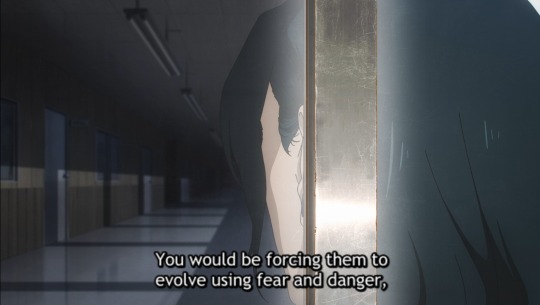

She may be right. Birds may have evolved flight, at least in part, because it helped them escape predators.
We honestly don't know.
Evolution doesn't care why. It only cares about if a species lives long enough to make more of itself. This is usually through finding food and finding a mate.
Some birds look so extravagant to find a mate

And some fly because it helps them hunt and reach food that other animals usually wouldn't be able to

What we do know is that birds came from the same line that gave us the therapods.
These guys
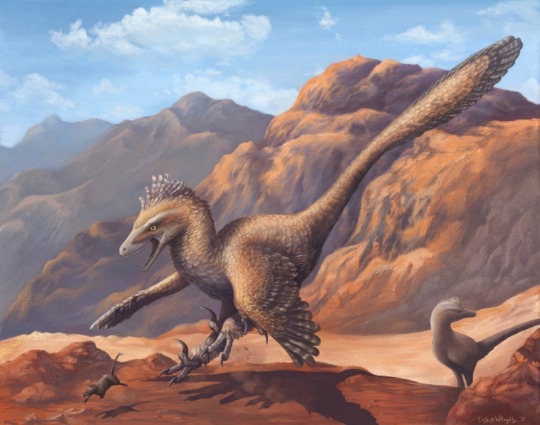

Then there's the oldest known bird

Archaeopteryx
These bad boys had sharp teeth and talons indicating they were carnivorous.
To me, this lends some weight to the theory that maybe birds evolved flight to chase after food that other animals couldn't. Flying bugs too high up unless you joined them and skittering lizards only caught through bursts of speed from descending on them from somewhere up high.
Current theories indicate that birds likely either evolved from arboreal species that hopped from tree to tree until that turned to gliding and then flying. Or, they came from species that started by running and hopping and, once again, eventually took to gliding and then flying.
We don't know the exact reason other than to live long enough to reproduce.
Maybe they were fleeing predators, but I don't think that was the only reason if so. I think they were looking for food, and their best bet was to take to the skies.
And that's why Yuki saying they evolved out of fear and danger is so frustrating to me. Fear is not the only reason a species evolves, and often is not the main one either.

I understand that, as sorcerers, they often see the worst of people and the world around them. And, as such, it is very easy to see those negative things as the reason the world turns.
But it's not.
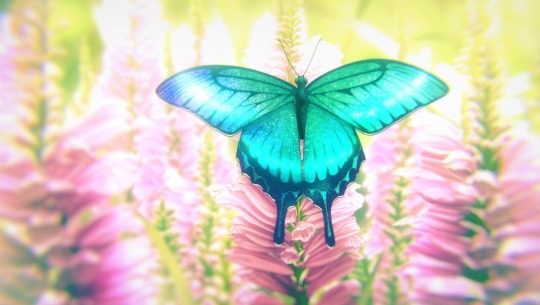
There's so much more

And the world is so much more complicated and beautiful than that
#i have a lot of thoughts and feelings on this#okay#jujutsu kaisen#jjk#jjk spoilers#jujutsu kaisen spoilers#jjk season 2#jjk yuki#tsukumo yuki#evolution
31 notes
·
View notes
Note
In a spontaneous act of bravery, I have decided to ask the first person on my feed some questions.
1) What is your third favorite dinosaur?
2) What is your favorite color combo?
3) Do you like my pets?

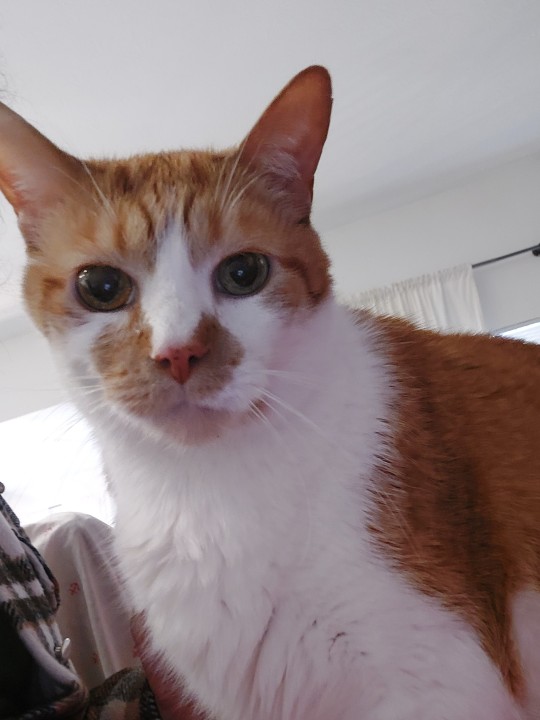
Hello Cal!!!
1. Archaeopteryx lithographica is my third favorite Dino- beat out by Ankylosaurus and Stegosaurus ❤️
2. My favorite color combo has to be either be teal and purple OR green and gold!
And 3. , ABSOLUTELY!!!
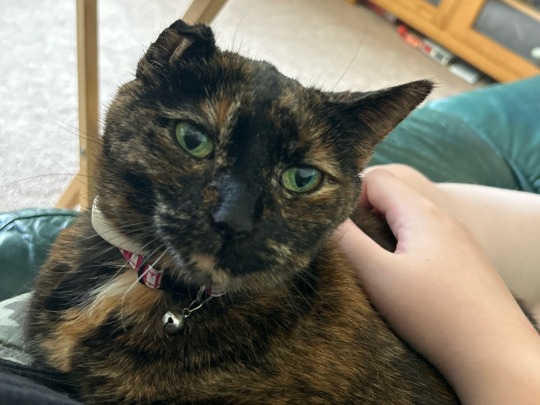
Here’s my baby too!
8 notes
·
View notes
Note
HAHHAA
You’ve come to a person with enough knowledge about paleobiology to possibly get a phd, I happen to have had a special interest in prehistoric animals since I was 3
So I present to you, my favorite thing ever created ever….
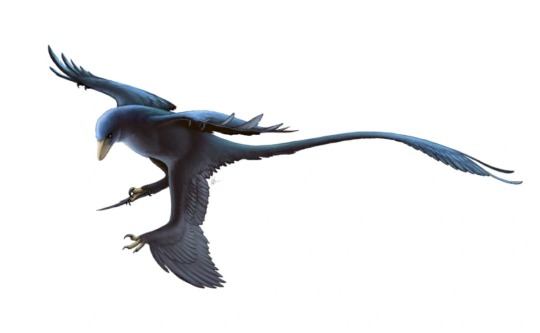

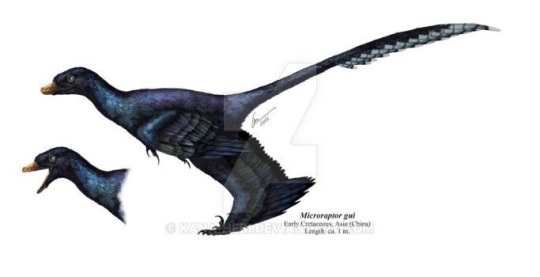
MICRORAPTOR!!
This is a non avian dinosaur (yes, birds are dinosaurs, however not all dinosaurs are birds. They’re all reptiles. Either a sparrow is a reptile or a nile crocodile is a bird, pick your poison.) that inhabited early Cretaceous China roughly 125mya! The iridescent black coloration was found in the pigmentation cells preserved in the feather impressions of multiple specimens (yes! We can tell a feathered dinosaurs colors if we have enough feather impressions! Archaeopteryx is a light beige with black tips on the edge, pictures further below)

This is the Microraptor Gui holotype specimen, or the specimen that is currently most representative of the species. You see all of those dark lines along the body and limbs? THOSE ARE FEATHER IMPRESSIONS!!!!! How cool is that?
Microraptor is currently in taxonomic limbo, however it’s known to be at least somewhat related to the dromaeosaurs, or “raptors” (YES, they were also covered in feathers and even had arm wings!). It and Velociraptor are sorta very distant cousins
Also, microraptor is 2’6” long including the tail, and 4” thick at its thickest point (YES, I MEASURED IT). Teeny tiny, I love this guy so muchhh
As for some others, here’s a few cool little guys!
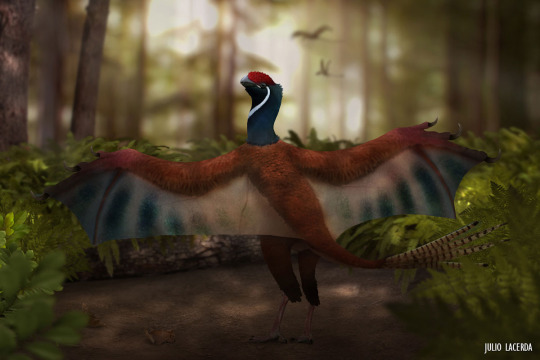
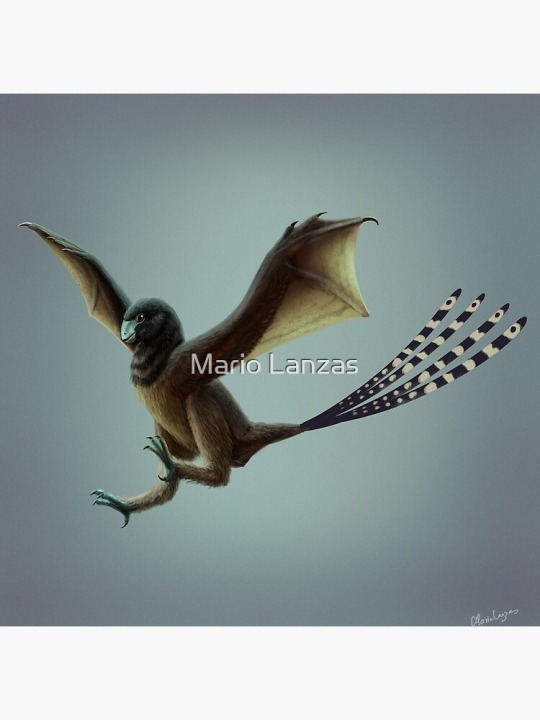

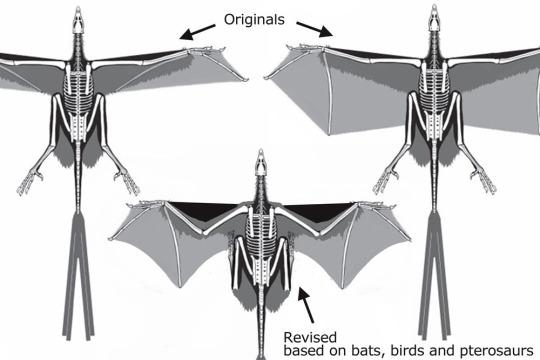
This is Yi-Qi, an absolute weirdo of a little guy who is just wonderful to me. They’re a dinosaur that lived in the Jurassic, roughly 159mya. They’re perfect, no notes

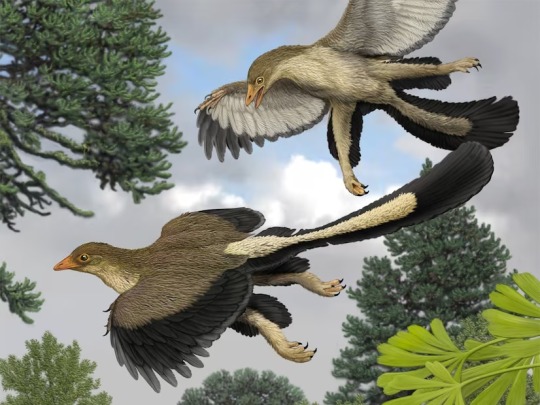
This is archaeopteryx! A sort of transitional form for early birds, this guy lived in the Jurassic, a whole 160 million years ago. The feather impressions shown on Microraptor are less prominent here, but are still noticeable if you know what to look for! This guy is not a true bird, but was a big first step in the evolution of flight feathers and the bird body plan :D
Yes, I will infodump about prehistoric animals at any given opportunity, if you want anything else just ask I reached the image limit :(
I’ll just… leave this here I guess?
#I don’t know what brought this on but that’s a lot of pretty Dino’s#so… slay#the first one is gorgeous#ghost talks
18 notes
·
View notes
Text
Enantiornithean Earth
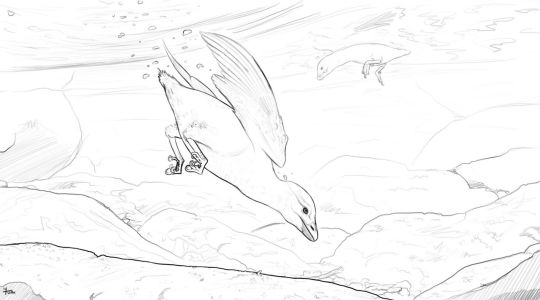

Yungavolucris and Halimornis by midiaou and xenopleurodon respectively. Both are real life Cretaceous taxa, showing that these birds were already diversifying into aquatic ecologies.
Enantiornithes are a group of extinct flying theropod dinosaurs that you could reasonably call birds, being the sister group of Euornithes (the group that includes modern birds). However, they differ from our birds in a variety of ways (their name literally means “opposite birds” for a reason):
Several skeletal details, including a tarsometatarsus that is either unfused or half-fused (beginning at the top rather than at the bottom, the opposite than in modern birds), an articulation of the scapula and coracoid that is oppositely shaped (hence the name; the coracoid joint is convex and the scapula joint is concave shaped in enantiornitheans, while the opposite happens in modern birds), a shallower sternum keel with bizarre antler-like projections (which, combined with large crests in their humerus, suggests the muscles lifting the wing were attached to the back as in bats and pterosaurs, rather than all flight muscles being attached to the keel as in modern birds), and a large, rod-shaped pygostyle (which will be relevant later).
Usually toothed jaws instead of beaks, though some taxa did become toothless. Even then, these weren’t capable of cranial kinesis like modern birds (i.e. watch a duck or your pet parrot yawn and you can see them moving their upper jaw; enantiornitheanss are many things but they’re not that abominatory).
All known taxa thus far seem to have been superprecocial: ample sites show buried eggs like those of megapodes, and the hatchlings were already fully flight capable soon after birth.
Unlike modern birds, enantiornitheans lacked a tail fan. They either had contour feathers on their butt like in the rest of the body or had long, streamer-like display feathers, also found in other Cretaceous bird groups but not in modern birds. Some species did have retrices, but they were arranged along the rod-like pygostyle and were not a movable fan, so essentially they were a variation of the tail fronds seen in Archaeopteryx and kin. Note that this did not make flight harder; even modern birds can fly reasonably well without a tail.
Why the opposite birds died out at the end of the Mesozoic while ours survived is unclear. Often, a bias towards arboreal niches is cited, as many enantiornitheans were in fact arboreal, but as the examples above show they also occured in marine and terrestrial niches alongside the ancestors of modern birds. Another possibility is their supreprecocial habits, meaning a more complex ecology as the birds matured since they were already functionally independent since birth, and this did hinder reptiles like lizards so the answer might lay there.
Or, most likely, it was just dumb luck.
Anyways:

Senmuruy hvare by Dave García. A four meter wingspan predator vaguely analogous to the golden eagle and cinnereous vulture, soaring across the northern hemisphere for corpses to dig its long snout into or live mammals and birds to sink its talons into.
Many Cretaceous enantiornitheans were already suspected of being raptorial, so it is only natural that, once pterosaurs were gone, they’d increase in size. Some reach wingspans of fiver meters, but most are more moderately sized at 1.5-3 meter adult wingspans. Smaller sizes are handled by the young, which like all enantiornithes can already fly since birth and occupy distinct ecological niches. Most species protect the nest and moderate its temperature like our megapodes, and a few even display mild parental care, allowing the young to remain in the vicinity until they’re large enough to be competition.

Euodontopteryx anatosuchus, a six-meter wingspan pelagic soarer that occurs in tropical and temperate waters, using its massive wings to ride on thermals like frigatebirds while landing to feed like albatrosses. Males sport streamer-like display feathers. By Dave García.
As noted above, some Cretaceous enantiornitheans were already aquatic, so this trend continued. Some species became divers, mostly wing propelled and some even flightless like our penguins, while others inversely invested in supreme gliding abilities, able to either ride thermals like frigatebirds or wave winds like albatrosses.
The most impressive species are reccord beaters. Divers can be as tall as a man when on land, while soarers can reach wingspans of over 7 meters, competing with flying multituberculates for largest living flying animals. Both groups tend to have long, toothy maws, the teeth alloted into a single row rather than individual sockets; this condition is known in both extinct sea birds and reptiles as well as some living cetaceans, and is known as aulacodonty.
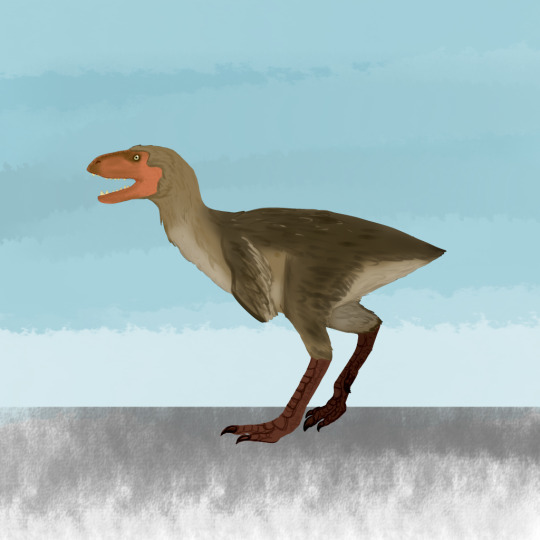
Ghaltavis rex, a three meter tall predator that stalks African and Asian savannas. An apex predator of its own right, an echo of the distant unrelated tyrannosaurs in the form of a bird. By Dave García.
At least one real life enantiornithean, Elsornis, appears to have been flightless. It’s descendents were quick to occupy roles previously taken by non-avian theropods, from ratite-like herbivores to formidable predators that look like the fusion of a terror bird and a tyrannosaur, using their powerful jaws to crush bone.
The relatively long enantiornithean pygostyle allowed them to balance their pelvis/femur joints (a known size inhibittor in our birds) and grow to sizes larger than our timeline’s birds, though species above a ton are fairly rare seeing as mammals got their footing as well.
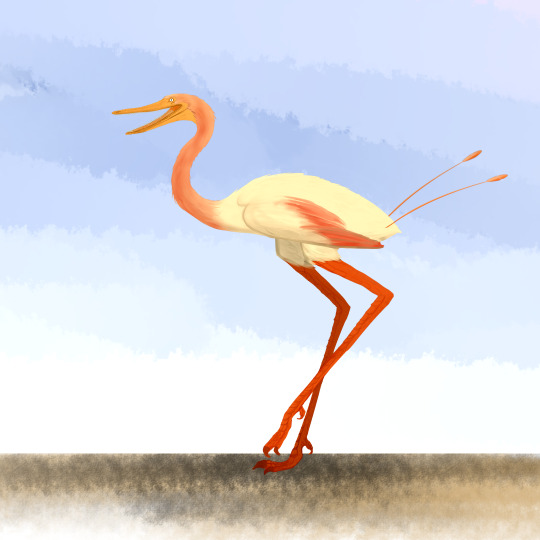
Bennu seti, a filter-feeding bird from Africa, Eurasia and Australia. Like flamingos it metabolizes carotenoids, giving it an orange colouration. By Dave García.
The Cretaceous Lectavis had long legs in some aspects convergent with those of flamingos. Thus, several enantiornitheans developed wading ecologies, ironically more associated with their euornithean competitors. Some became probers, dipping their maws (or toothless beaks) into the subtrate, while others became piscivores like herons or aquatic plant specialists like some cranes and magpie geese.
Most spectacular is a filter-feeding clade, Bennuidae. These birds modified their teeth into thin, delicate strands like some Cretaceous pterosaurs, and feed by swallowing water and expelling it, trapping prey in the teeth and keratinous spikes in the tongue. Having the nostrils still at the end of the snout, these birds usually feed in a different position from flamingos: rather than upside down, the lower jaw is submerged, in a manner similar to avocets.
Like most opposite birds the young are superprecocial, starting as plover-like birds before transitioning into a filter feeding lifestyle months later. Though some taxa form protective creches like flamingos, though unlike them they do not feed the young.
Like many of our shorebirds, these are continuous flappers, displaying remarkable endurance as they fly non-top for days in their migrations.
#enantiornithes#enantiornithean#enatiornithine#bird#birds#dinosaur#dinosaurs#paleoblr#palaeoblr#speculative zoology#speculative evolution#speculative biology#spec evo
26 notes
·
View notes
Text
sorry for not including any sauropods. as if its my fault
jokes. i had to choose between 12 of my faves and unfortunately no sauropods made the cut. (Eoraptor lunensis was close tho, it was either that or O. philoceratops and i only barely like the latter more)
also excluded was Archaeopteryx lithographica bc i had a feeling it would sweep simply by virtue of being the most famous dinosaur on the list by far
9 notes
·
View notes
Text
Feytouched Companion (Animal Companion Archetype)

(art by Rock-fairy-art on DeviantArt)
We’re back again with another one of those “not quite an animal” archetypes for your animal companion (the last of them, I believe), and this time we’re looking at one for the fey creature type!
These so-called feytouched companions might have been altered by the primal energies of the first world, or they might have been born there as one of the strange animals that never made it to the final draft of reality. Either way, they are beings beyond the natural, yet inextricably part of nature.
Such beasts might sport unusual colorations, exotic or eccentric-looking features, and more, or they might even look entirely different, being a strange animal that fulfills the same ecological niche with the same adaptations, but be from another world or never having existed on the material plane at all.
No matter their appearance or origins, however, these animals gain more than an odd appearance from their origins, having minor magics and surprising power despite their size.
Indeed, it’s something of a curiosity that these companions always seem to take the forms of animals that start as Small or smaller creatures, though they need not stay that way as they grow and mature.
Regardless, they have plenty of curious abilities up their sleeve, which we will detail now.
These beasts have a natural love of attention and otherworldly features, making them easy to train to perform. However, this otherworldly nature makes them more difficult to train in other areas.
They universally appear among creatures that at least start out small, but they are stronger than they look, all of their physical abilities bolstering when they come of age, though they remain small.
What they get in exchange, however, is a wellspring of magical power. On their own, they can only create floating lights, but if they team up with their master, they can combine their master’s spellcasting power with their fey nature to cast a variety of spells, ranging from illusions, mind-warping effects, and the like.
Their fey natures also make them resilient to mortal harm, though cold iron pierces it like any fey.
This archetype differs from the other blurred creature types with the addition of spellcasting, which it makes up for by always remaining smaller than normal. As such, these companions are likely not going to be front-line fighters, though they can hold their own thanks to their physical enhancement. Instead, you’ll probably want to use them for mostly utility roles, focusing on stealth and agility. In combat, you’ll likely keep them close so you gain access to the additional spells they grant. It goes without saying that you’ll probably only ever see this archetype paired with a class that actually gets spellcasting.
Perhaps one of the more interesting questions that arises with any of these blurred creature type companion archetypes is the story of how the character came across them. Some like the augmented archetype are easy, but feytouched and other more supernatural ones have more options than deliberate changes. It may have been a fateful encounter, a gift from a powerful fey, and so on.
The Balsyaman Jungle is well-known as a primeval place. Not only do dinosaurs roam it, but portals to the fey realms are common. Poachers seeking rare beasts often come there, in particular feytouched archaeopteryx are popular targets now, but the lizardfolk druids that watch over the jungle make sure they pay dearly for every beast taken.
Though she is called the “Sea Enchantress”, Mikvana the azarketi (gillfolk) is actually trained as a ranger. Her anglerfish companion, however, has the touch of the fey, and through it she can manifest mind-bending spells to entrap the enemies of her people.
Terrorized petitioners, the victims of the sahkils, have little hope on their own, but there are those who dare to venture into Xibalba and rescue them. One such figure is Ilfixi, a gathlain hunter and her plane-hopping companions. Alongside her giant ant companion, she raids the monstrous ethereal pyramid at great risk to herself.
#pathfinder#archetype#animal companion#feytouched companion#archaeopteryx#lizardfolk#gillman#anglerfish#sahkil#petitioner#gathlain#Ultimate Wilderness
8 notes
·
View notes
Text
The Archen Family

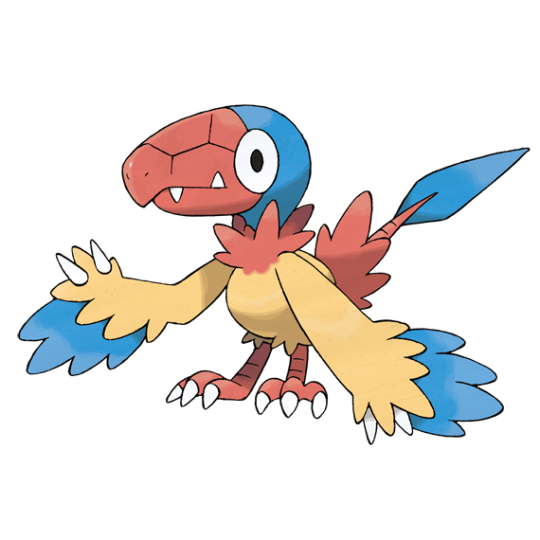
Archen, meanwhile is the much more interesting fossil ‘mon in terms of design. Its name and appearance draws a clear connection between it and the Archaeopteryx, a prehistoric animal that helped draw better connections between dinosaurs and modern day birds.
As such, Archen has a pleasantly feathery appearance, and a big scaly, toothy beak. It definitely feels like a more authentic prehistoric bird than Aerodactyl did, and has a nice vibrant color palette to boot.
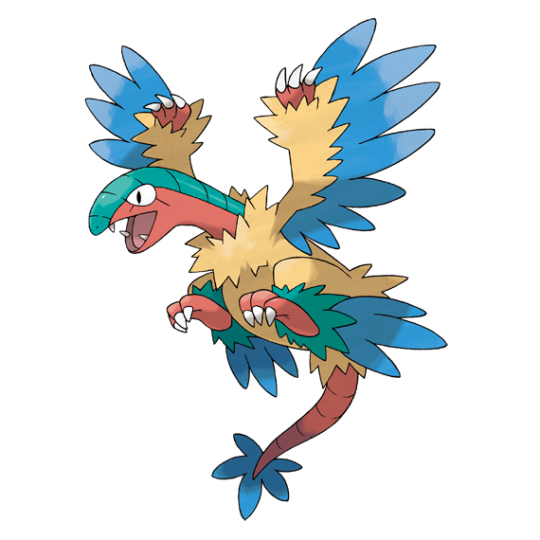
Archeops is this Rock/Flying type family’s final form, and I really like how much more pf a cartoonish dinosaur it’s become. The head and tail feel much more reptilian with plated scales, but a bunch of big, colored feathers still remain. It’s a real cool one, and the fact that it flaps around manically in its idle animation is pretty funny, as if it hasn’t exactly figured out flying yet.
For whatever reason though, both Archen and Archeops are burdened with the confounding Defeatist ability. Whenever their health drops below 50%, Archen or Archeops’ attacking stats will effectively be cut in half. It’s never stated in any Pokedex entry why either Pokemon would suffer from such an ability, and it really feels like an unfair hindrance to both of them. Slaking and Regigigas at least had thematic reasons for their abilities, Archeops just seems unlucky.
Score: 4/5

Oh well. The design’s fun, at least.
[Gen 5 Archive]
4 notes
·
View notes